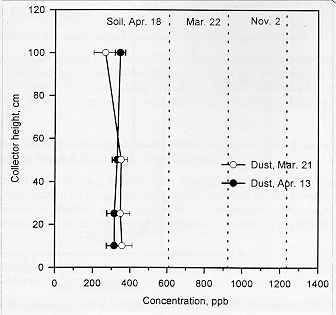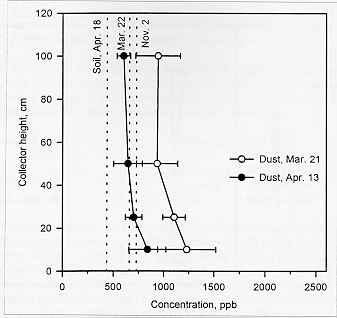| | Problem | Literature review | Study description | Major findings | Applied questions | References
Problem
Wind erosion is a pervasive soil degradation problem on the semi-arid Canadian prairies. As well as removing valuable nutrients from the soil surface, wind erosion may also have the potential to transport herbicides. However, few studies have been conducted on this mechanism of herbicide transport which may have off-farm impacts on water and air quality.
Literature Review
The movement of herbicides by water is well documented, but few reports are concerned with herbicide transport in windblown sediment. One study reported that approximately 43% of simazine was removed from a treated area by wind erosion on a sandy soil in southwestern Ontario5. The simazine was deposited downwind at quantities sufficiently high to be phytotoxic to susceptible crops or to impair the quality of adjacent irrigation ponds or waterways. Another study reported movement of atrazine, simazine and alachlor by wind erosion in Maryland6.
Recently, there has been much interest in the impact of wind erosion on off-site air quality and human health7,8,2. Many urban areas have experienced concentrations of particulates with diameters less than 10 microns (PM10) which exceed air quality health standards1. These particulates are capable of being transported long distances, and if they emanate from agricultural land, they may carry with them herbicides and pesticides.
There is no information on the potential for wind erosion to transport herbicides under southern Alberta conditions. The objectives of this study were: to determine herbicide concentrations in windblown sediment trapped at four heights; and to compare herbicide concentrations in windblown sediment with those in the source soil surface.
Study Description
The study site was established in April 1993 on a Dark Brown Chernozemic clay loam soil about 15 km southeast of Lethbridge, Alberta. The study site consisted of a single circular plot, 200 m in diameter with an area of 3.14 ha. The circle was conventionally fallowed with a heavy-duty cultivator from April to September 1993. This created an erodible surface surrounded by a non-erodible surface protected by standing stubble.
The site was sprayed with trifluralin and triallate on October 26, 1993 which were incoporated with a heavy-duty cultivator and rodweeder. Diclofop and bromoxynil were surface-applied on October 30, and Mecoprop and 2,4-D on October 31, 1993. Application rates (in grams of active ingredient per hectare) were as follows:
Soil-incorporated | Surface-applied |
Trifluralin
Triallate
| 1400 g a.i./ha
1417 g a.i./ha
| Diclofop
Bromoxynil
Mecoprop
2,4-D | 805 g a.i./ha
280 g a.i./ha
1606 g a.i./ha
1129 g a.i./ha |
The site was instrumented with windblown sediment collectors, anemometers and two SENSIT erosion sensors on November 1, 1993. Thirteen clusters of Big Spring Number Eight windblown sediment samplers3 were installed on the circle on November 1, 1993. A cluster comprised an upright with four samplers positioned approximately 10, 25, 50 and 100 cm above the soil surface. Six clusters were located in each of two concentric circles at 60 and 95 m from the centre of the circle. Five clusters of collectors were also placed on the depositional area (standing stubble) downwind (east) of the erodible circle.
Thirteen erosion events were monitored between February and April 1994, with a total soil loss of 56.6 t/ha. Soil losses were calculated by the method of Fryrear et al.4 Sediment trapped at the four collector heights during the two largest events (March 21, 1994, 17.3 t/ha soil loss; and April 13, 1994, 19.6 t/ha soil loss) was analyzed for herbicide concentrations.
Surface soil samples were taken on November 2, 1993, March 22, 1994 and April 18, 1994, at 0 to 2.5 cm depth. Twenty samples were taken on a west-east transect at 10-m intervals across the circle, and these were analyzed for herbicide concentrations for comparison with those of the windblown sediment trapped on March 21 and April 13, 1994. Soil surface samples were also taken on the depositional area to the east of the circle.
Major Findings
Results from three of the herbicides (trifluralin, 2,4-D and diclofop) are presented. For trifluralin, concentrations in dust trapped during the wind erosion events of March 21 and April 13 were much lower than in the surface soil on all three sampling dates (Figure 1). This is probably because the trifluralin was incorporated to 10 cm depth by tillage, hence reducing the concentration in the very shallow surface layer removed by wind erosion. There was no effect of collector height on trifluralin concentration for either wind erosion event. There was no difference in concentration between the two erosion events. There was, however, a decrease in concentration in the surface soil from November 2, 1993 to March 22 and April 18, 1994. Most of this loss may be attributed to volatilization of trifluralin into the atmosphere9.

Figure 1. Effect of collector height on trifluralin concentration in dust,
1993-94. Dotted lines represent concentrations in surface (0-2.5 cm) soil.
The behaviour of surface-applied 2,4-D (Figure 2) was different than that of soil-incorporated trifluralin. Concentrations in the dust for the March 21 event were higher than in the surface soil on November 2, 1993 and March 22, 1994. Concentrations in the dust for the April 13 event were higher than in the surface soil on April 18. Concentrations in the dust at all four heights were higher for the March 21 wind erosion event than the April 13 event. There was a trend for dust trapped at the 10- and 25-cm heights to have a higher concentration of 2,4-D than the dust at the 50- and 100-cm heights.
Figure 3 shows the effect of distance from the protected surface on diclofop dust concentrations for the April 13, 1994 storm. As the distance from the protected surface increased there was a significant linear decrease in diclofop concentrations in dust. This agrees with visual assessments in the field. After the large erosion event of March 21, topsoil (and hence diclofop) losses were greatest as distance from the protected surface increased. Consequently for the April 13 event, there was less surface diclofop available for removal as distance from the protected surface increased, and this is reflected in diclofop concentrations in the trapped dust.

Figure 2. Effect of collector height on 2,4-D concentration in dust,
1993-94 Dotted lines represent 2,4-D concentrations in surface (0-2.5 cm) soil.

Figure 3. Effect of distance to protected surface on diclofop concentration
of dust captured during erosion event of April 13, 1994 (all four hights, n=49)
Applied Questions
Is there a potential for transport of herbicides in windblown sediment?
Yes. The study results point to the potential hazard of environmental transport of herbicides in windblown sediment which may have implications for air and water quality. Wind erosion events affect air quality. If dust containing pesticides is inhaled, there may be an impact on human health. If the dust is deposited in waterways, then there may be a detrimental effect on water quality.
Why were dust concentrations of trifluralin lower than in surface soil and dust concentrations of diclofop higher than in surface soil?
Soil-incorporated herbicides (e.g. trifluralin) are worked into the top 10 cm of soil by tillage implements, thus diluting the concentration over a 10-cm depth. On the other hand, surface-applied herbicides are adsorbed to soil particles in the very shallow surface layer which is the first to be removed by wind erosion. Hence the potential for removal of surface-applied chemicals by wind erosion is much higher.
Why were dust concentrations of diclofop lower for the April 13 wind erosion event than for the March 21 erosion event?
The initial large event on March 21 removed soil particles which contained the highest concentrations of diclofop, thereby exposing material with lower concentrations of diclofop which was transported in the second large storm of April 13.
What preventative measures can be taken to reduce herbicide transport by wind?
Firstly, every effort must be made to reduce erosion risk by judicious residue management. Secondly, high rates of herbicides should not be applied to erosion-prone soils. There is a confounding factor with soil-incorporated herbicides. Incorporation increases herbicide efficacy but also buries crop residues that help to prevent erosion. However, the results of this study show that the potential transport of soil-incorporated herbicides by wind is much lower than that of surface-applied herbicides.
References
- Clausnitzer, H. and Singer, M.J. 1996. Respirable-dust production from agricultural operations in the Sacramento Valley, California. J. Environ. Qual. 25: 877-884.
- Coates, W. 1996. Particulates generated by five cotton tillage systems. Trans. ASAE 39: 1593-1598.
- Fryrear, D.W. 1986. A field dust sampler. J. Soil Water Cons. 41: 117-120.
- Fryrear, D.W., Stout, J.E., Hagen, L.J. and Vories, E.D. 1991. Wind erosion: field measurement and analysis. Trans. ASAE 34: 155-160.
- Gaynor, J.D. and MacTavish, D.C. 1981. Movement of granular simazine by wind erosion. HortScience 16: 756-757.
- Glotfelty, D.E., Leech, M.E., Jersey, J. and Taylor, A.W. 1989. Volatilization and wind erosion of soil surface applied atrazine, simazine, alachlor and toxaphene. J. Agric. Food Chem. 37: 546-551.
- Saxton, K.E. 1995. An interim technical report of the Northwest Columbia Plateau Wind Erosion Air Quality Project. Washington State University, College of Agriculture and Home Economics, Pullman, WA. Misc. Publ. No. MISC0182. 47 pp.
- Saxton, K.E. 1995. Wind erosion and its impact on off-site air quality in the Columbia Plateau--an integrated research plan. Trans. ASAE 38: 1031-1038.
- Taylor, A.W. and Spencer, W.F. 1990. Volatilization and vapor transport processes. Pages 213-269 in H.H. Cheng (ed.), Pesticides in the soil environment: processes, impacts and modeling, Book Series No. 2, Soil Sc. Soc. Amer., Madison, WI.
Return to CAESA Soil Quality Program Research Factsheets
This information is provided by F. J. Larney , A.J. Cessna and M.S. Bullock.
|
|